科研人员找到玉米驯化关键基因
来源:《PNAS》
作者:Qin Yang
时间:2013-12-16


近日,美国《国家科学院院刊》在线发表了华中农业大学教授严建兵及其合作者的最新研究成果,该成果为解释玉米从短日照到长日照的驯化找到了“钥匙”。
玉米原产于墨西哥,属于短日照区,而世界上包括中国在内的玉米主产区都属于长日照地区,如何解决玉米对不同地区的日照长度的适应,一直是科学家们亟待解决的关键问题。
研究人员对一个来源不同,具有广泛多样性、代表性的500余份玉米自交系从南到北进行了种植并调查其开花时间,利用覆盖全基因组的高密度分子标记,结合全基因的关联分析找到了一个影响开花期的关键位点。这个位点是一个包含CCT结构域的基因,命名为ZmCCT,其携带一个CACTA型转座子,能有效减弱玉米对光的敏感性,有助于玉米从热带到温带地区的扩散,对于揭示玉米的适应性机制、帮助品种选育具有重要意义。
“有证据表明CCT及其同源基因在调控植物的光周期方面可能起重要作用。”严建兵认为,包含CCT结构域的这类基因可能通过影响光周期进一步影响农作物的其他关键农艺性状,是一个有重大价值、可应用于作物遗传改良的关键基因。(来源:中国科学报 鲁伟)
CACTA-like transposable element in ZmCCT attenuated photoperiod sensitivity and accelerated the postdomestication spread of maize
Abstract The postdomestication adaptation of maize to longer days required reduced photoperiod sensitivity to optimize flowering time. We performed a genome-wide association study and confirmed that ZmCCT, encoding a CCT domain-containing protein, is associated with the photoperiod response. In early-flowering maize we detected a CACTA-like transposable element (TE) within the ZmCCT promoter that dramatically reduced flowering time. TE insertion likely occurred after domestication and was selected as maize adapted to temperate zones. This process resulted in a strong selective sweep within the TE-related block of linkage disequilibrium. Functional validations indicated that the TE represses ZmCCT expression to reduce photoperiod sensitivity, thus accelerating maize spread to long-day environments.
Significance Maize was domesticated from teosinte in Southern Mexico roughly 9,000 years ago. Maize originally was sensitive to photoperiod and required short-day conditions to flower. Thus, the reduced sensitivity to photoperiod is prerequisite for maize spread to long-day temperate regions. A gene encoding a CCT domain-containing protein, ZmCCT, was found by many researchers to modulate photoperiod sensitivity. The current study shows that insertion of a CACTA-like transposon into theZmCCT promoter can suppress the ZmCCT expression remarkably and thus attenuates maize sensitivity under long-day conditions. The transposable element (TE) insertion event occurred in a tropical maize plant and has been selected for and accumulated as maize adapted to vast long-day environments. This selection leaves behind a TE-related linkage disequilibrium block with the very-low-nucleotide variations.
原文链接: http://www.pnas.org/content/110/42/16969.full.pdf+html




